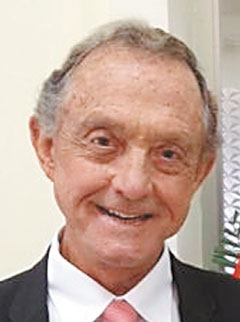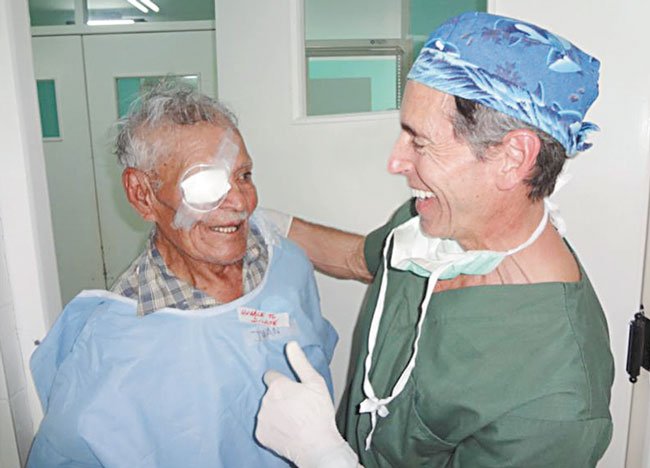Eye Care From Hawaii To The World

DR. JOHN CORBOY
Founder and president of Hawaiian Eye Foundation
What is Hawaiian Eye Foundation, and is it related to Hawaiian Eye Center?
There is no current relationship, but I was president and founder of Hawaiian Eye Center in 1975. Later I began running what I called Royal Hawaiian Eye Meeting (RHEM). In the early ’80s I established Hawaiian Eye Foundation to be the repository of the profits from that meeting, which were then devoted to our annual charity eye-care trips to the South Pacific, starting in Tonga.
Hawaiian Eye Center takes care of people in Hawaii, whereas Hawaiian Eye Foundation does some philanthropy in Hawaii, like mentoring students and judging and awarding projects at the state Science and Engineering Fair, but we don’t actually deliver eye care in Hawaii. We take care of the blind in Fiji, Palau, Kiribati, Samoa or Tonga and elsewhere.
Once I retired from active clinical practice 15 year ago, I became busy doing voluntary eye-care missions all over Asia and the South Pacific. We were so successful that we then were invited to Mexico, Bolivia, Nicaragua, the Bahamas and Dominican Republic.
052715_dih_1.jpg
What happens during your overseas programs?
We have three different programs. The first is going to islands where there is no eye doctor and delivering charity care to the blind, mostly cataract surgery. Second, which is more common, is going to a Pacific island where there is an eye doctor, but he’s using old equipment, methods and instruments. We sit with him in the operating room, one-onone, teaching better methods with modern equipment, and providing him with supplies and instruments. We’ll work with him all day, for a week or more, teaching him how to do better work with improved results.
The third method is training programs, where we gather 300-400 doctors and bring a large faculty, teaching them with lectures, demonstrations and videos. We train them on pigs’ eyes. We began these programs in Vietnam 12 years ago. Just last December, I traveled to receive a gold medal from the Health Ministry of the Socialist Republic of Vietnam, recognizing our foundation for more than a decade of training thousands of Vietnamese eye surgeons. We have recently begun a similar training program, Myanmar Eye Meeting, at the invitation of the Burmese government.
What work does the foundation do here on Oahu?
We work in conjunction with Project Vision Hawaii. They have a van from which they do screening and provide eyeglasses on all of the islands, for people in rural areas who are not well-served. We collect donations of supplies and instruments from across the U.S. for Project Vision, and we recently donated a large motor coach for the work they do.
You mentioned that you work with Hawaii students as well?
High school and junior high school students submit their projects on eyes or vision to the state Science and Engineering Fair. When requested, we mentor them. For example, one might do a project on glaucoma. We’ll help them research and prepare their project. We also do judging of eye and vision projects at the various district fairs, and provide prizes to those with the best presentations on eyes and vision.
We’ve always taken young people who are interested in medical careers on our mission trips with us. We’ve brought high school and college kids from Hawaii and elsewhere in the U.S. They volunteer to come along with us on short trips to Mexico, or longer trips to the South Pacific or South America.
Paying your own way is pricey, so we’re in the process of creating a scholarship program, ISLE (International Service Learning Expeditions), to assist local kids and help with their expenses when they volunteer with us. We’re interested in sponsoring young people who have a passion to help us deliver compassionate care in the Third World, where people are so impoverished and in need of medical care of all sorts.
Can you say something more about the yearly RHEM you founded?
For 34 years, more than 1,000 doctors, nurses and technicians come to Hawaii annually to study the latest in eye care and surgery. We rotate the meeting annually through the different islands. Our foundation’s meeting has long been the third-largest annual eye meeting in the U.S., and we continue to play a role, but we have turned administration over to a management company.
How does working overseas in Third World countries compare with working here in Hawaii?
Overseas, we work under far more challenging conditions, caring for people who are far more visually handicapped. People in Hawaii are well-served compared with work we do elsewhere. For instance, on a remote island in Fiji, it may be a three-day boat trip to get to a clinic. Some of our work has been done from a sailboat, where we’d go to far-flung islands in the northern archipelago of Tonga to a small clinic run by a nurse. We’d help her set up field operations, often without electricity or other amenities.
Much of what we do is cataract surgery. There are huge differences between cataract surgery here and overseas. In Hawaii, when you start to get blurry vision that doesn’t improve with eyeglasses, and you have difficulty doing the simple things you need to do, whether sewing, reading, watching TV or driving, your doctor may diagnose a cataract and offer to fix you.
In the South Pacific or Asia, these patients’ vision has further deteriorated to where they have a challenge doing everything. Their vision may be so poor that they can barely see their fingers in front of their face, and it gets worse. Many have never seen their grandchildren. Usually, they are totally incapacitated, barely able to tell night from day. We go in there and, in 10 minutes, out comes their cataract, and in goes a new artificial plastic lens. They sit up on the operating table and say, “Oh, my god, I can see again!” The patient cries. I cry! It becomes like a drug for us, to be able to bring so much joy every week to hundreds of people who have never seen their grandchildren. It is so tremendously rewarding.
Our work actually affects two lives. A young child in every household has to look after his blind grandmother, leading her to the outhouse, to market and to church. Wherever she goes, this child has to guide her along. Once Grandma can see again, the child is free to go to school like a regular kid.
Anything else you’d like to mention?
Everyone in our foundation volunteers, paying their own way. Ninety-five cents of every dollar we receive in donation goes into direct patient care and services. In our headquarters in Mililani, we collect instruments that have been donated for further use in our scattered clinics, for training thousands of doctors and for the tens of thousands of cataract surgeries we’ll perform.
We represent Hawaii all over the world, from Burma to Bolivia. We’re doing tremendous good work with thousands of sight-restoring surgeries annually. Last year in South Africa, I received an honorary lifetime membership in South African Society of Cataract and Refractive Surgery for work our foundation did during apartheid, when South African surgeons couldn’t get visas to attend U.S. ophthalmology meetings. We went there every other year with a team to train South Africans, just like we are now doing in Vietnam.
One of the most satisfying things we do, beyond restoring vision to the blind poor of the Pacific, is inspiring young people with a passion to do what we do ―freely serve those less fortunate. We are thrilled when high school kids want to volunteer with us or doctors want to donate their time and talent. I love speaking at local schools because the exposure is invaluable. Students hear about what we do, and want to be a part of our humanitarian efforts to leave the world a better place.
They even may change career plans and decide to go to medical school, nursing school, optometry or dental school. That’s where we change lives locally, just like we change lives overseas.






